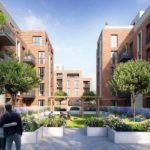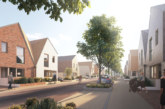Andrew Bickerdike, Director, Planning at Turley discusses the ways the pandemic has changed city centre living and why urban living developments need to adapt as a result.
Months of lockdown and restrictions have generated debate about what’s important for people when it comes to housing. Whilst it would be premature to suggest fundamental and long term changes to how people live their lives and what they want from their homes, the development industry must be alive to this debate and consider what this may mean for their future investments.
Shifting attitudes, new requirements for housing and changing demand for city centre residential products have demonstrated just how beneficial building flexibility into a scheme’s design will be in the future. Doing so has the potential to create new opportunities for different residential models to be accommodated in city centres, as the market adapts to reflect where renters and investors’ priorities lie.
Take co-living, for example. Even before the pandemic, co-living schemes had cemented their place in London’s housing market and were slowly being adopted and considered by cities like Manchester and Bristol. But in a post-COVID world, they could become even more commonplace in UK cities as people look for flexible city centre accommodation. An additional benefit is that people may take up co-living if they want a smaller secondary home as another place of residence if they don’t need to be in the city five days a week.
Risk management is key
While these new residential models successfully meet the demands of renters and investors, it is also crucial to consider how the market can adapt existing residential developments to meet changing expectations.
The need to manage market risk through the planning process is not a new concept, but it is now more important than ever as recent events have shown us how quickly the market can change direction.
Designing schemes in a way that can be switched to alternative residential use means that schemes have a plan B already built in. For example, co-living can be adapted into a conventional residential development if market demand moves away from one model of living to another.
Local Authorities are already acutely aware of this and understand that flexibility within design simply makes commercial sense. With the decline of the traditional high street, Local Authorities do not want empty buildings in their town centres and often request that developers can demonstrate how schemes can be adapted to other forms of residential development to manage risk in evolving markets.
Purpose-built student accommodation (PBSA) is a good example of where risks are starting to materialise. Many developments are lying empty as a result of the pandemic and consequently, developers must now consider how they can put their schemes to alternate use to recuperate some commercial return. This could be done through temporarily changing them into apart-hotels or serviced accommodation.
In many cases this can be achieved retrospectively through the planning process, but this will be harder to do if schemes aren’t designed from the outset with this flexibility in mind. In light of COVID, the PBSA market is already uniquely placed to adapt to different circumstances, given the pre-existing issue of beds lying empty during university holiday periods.
Crucially, however, other sectors of the urban living market must now also follow to guarantee resilience going forwards. If the sector is to maintain the growth experienced in city centres pre-COVID, housebuilders must focus on adapting residential developments to meet a renewed set of needs from renters and investors.
Across all models, including co-living and traditional residential developments, flexibility will be necessary from the outset if they are to be agile enough to respond to any further fluctuations in the urban living market.





